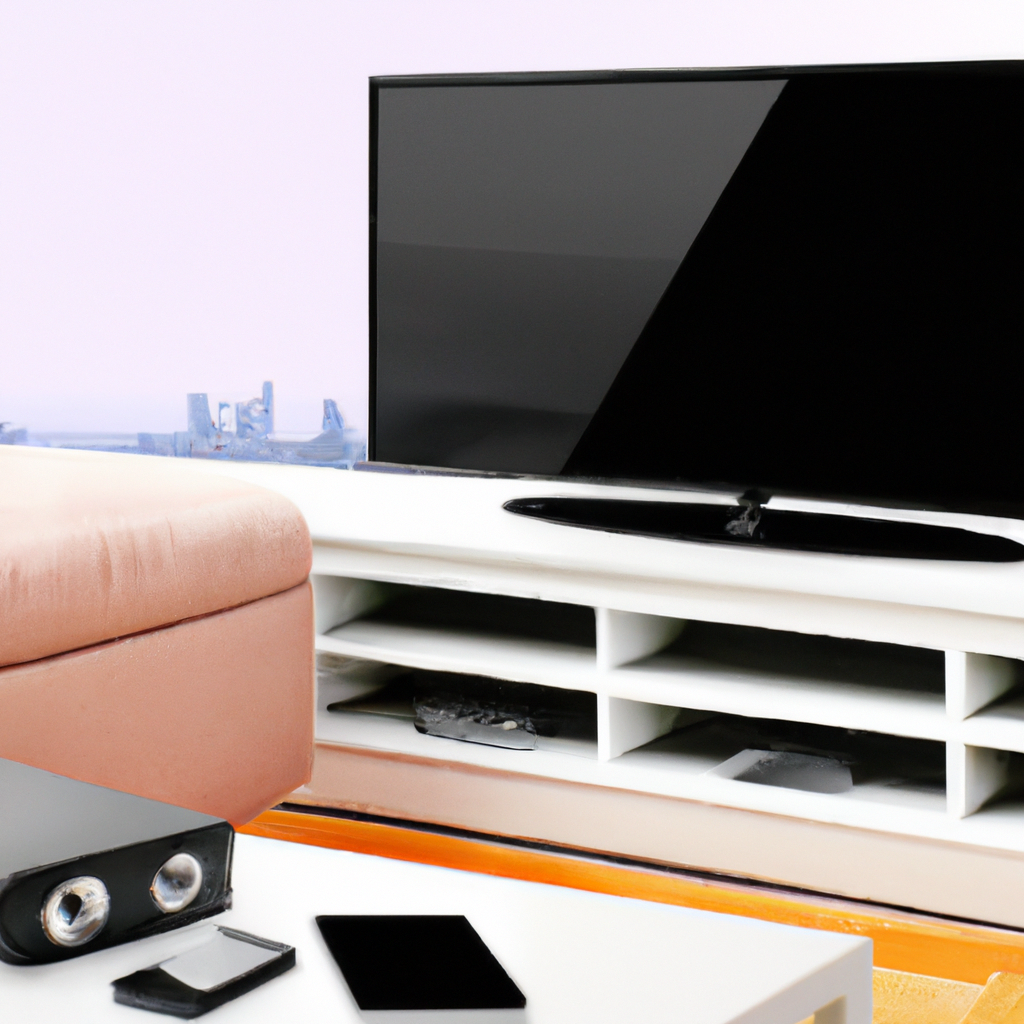Imagine being able to transform your ordinary living room into a personalized audio oasis with just a few simple steps. With the power of smart sound technology, you can enhance the acoustics of your living space and elevate your listening experience to new heights. By strategically placing speakers, fine-tuning audio settings, and harnessing the power of innovative sound systems, you can create a immersive audio environment that is tailored to your preferences. This article will guide you through the process of optimizing your living room’s acoustics using smart sound technology, revealing the secrets to achieving immersive sound quality in the comfort of your own home.

Choosing the Right Smart Sound Technology
Understanding the basics of smart sound technology
In order to optimize your living room’s acoustics, it is important to first understand the basics of smart sound technology. Smart sound technology refers to the use of advanced audio systems that enhance the listening experience by adapting to the unique characteristics of the room. This includes features such as automatic sound calibration, multi-room audio, and integration with smart home automation systems.
Exploring different types and options
When choosing the right smart sound technology for your living room, there are several types and options to consider. One popular choice is smart speakers, which are standalone devices that can connect to your existing entertainment setup and provide high-quality audio. Another option is soundbars, which are slim and sleek devices that sit below your TV and provide a surround sound experience. Additionally, there are wireless speakers that can be placed throughout the room for a more immersive audio experience.
Considering the compatibility with your existing entertainment setup
Before making a purchase, it is important to consider the compatibility of the smart sound technology with your existing entertainment setup. Ensure that the device you choose can seamlessly integrate with your TV, streaming devices, and other audio sources. Compatibility issues can lead to frustrating experiences and limited functionality, so it is essential to research and choose a system that works well with your existing setup.
Analyzing Your Living Room’s Acoustic Characteristics
Identifying reflections and echoes
One of the key factors in optimizing your living room’s acoustics is identifying and addressing reflections and echoes. These can occur when sound waves bounce off hard surfaces such as walls, floors, and ceilings, resulting in distorted audio. By identifying areas in your living room where reflections and echoes are prominent, you can take steps to minimize their impact and improve the overall sound quality.
Measuring the room’s natural reverberation time
The natural reverberation time of a room refers to how long it takes for sound to decay after it is produced. Different rooms have different natural reverberation times, which can significantly impact the way music and audio is perceived. Measuring the room’s natural reverberation time can help you understand the acoustics of your living room and make informed decisions when choosing smart sound technology.
Assessing the impact of furnishings and decor on sound quality
The furnishings and decor in your living room can have a significant impact on the sound quality. Soft furnishings such as curtains, carpets, and upholstered furniture can help absorb sound and reduce reflections, resulting in clearer audio. On the other hand, hard surfaces such as glass, metal, and bare walls can reflect sound waves and create unwanted echoes. By assessing the impact of your furnishings and decor on sound quality, you can make adjustments or additions to optimize your living room’s acoustics.

Positioning and Placement of Smart Sound Devices
Determining the ideal speaker placement for enhanced acoustics
The positioning and placement of smart sound devices play a crucial role in optimizing your living room’s acoustics. The ideal speaker placement will depend on various factors such as the size and shape of the room, the location of the seating area, and the desired audio experience. Generally, it is recommended to position speakers at ear level and in a way that ensures even distribution of sound throughout the room.
Considering the room dimensions and layout
The dimensions and layout of your living room are important considerations when positioning smart sound devices. The size of the room can affect the way sound travels and how it is perceived. Additionally, the layout of furniture, walls, and other elements can impact the distribution of sound waves. By taking into account the room dimensions and layout, you can optimize the placement of smart sound devices for a more immersive audio experience.
Using wall-mounted versus freestanding speakers
When it comes to speaker placement, you have the option of using wall-mounted speakers or freestanding speakers. Wall-mounted speakers can save space and provide a cleaner look, while freestanding speakers offer more flexibility in terms of positioning and can often provide better sound quality. Consider the aesthetics and functionality of your living room when deciding between wall-mounted and freestanding speakers.
Calibrating Smart Sound Systems
Understanding the importance of calibration
Calibration is a crucial step in optimizing the performance of your smart sound system. It involves adjusting various audio settings to ensure that the sound is balanced and tailored to the specific characteristics of your living room. Calibration helps eliminate any discrepancies in sound quality and ensures that you are getting the best possible audio experience.
Utilizing built-in calibration tools
Many smart sound systems come with built-in calibration tools that make the calibration process easier and more user-friendly. These tools typically use microphones and sensors to measure the acoustic characteristics of your room and automatically adjust the audio settings accordingly. By utilizing these built-in calibration tools, you can achieve optimal sound quality without the need for complex manual adjustments.
Exploring advanced manual calibration methods
While built-in calibration tools are convenient, some advanced users may prefer manual calibration methods for more precise adjustments. This can involve using external microphones, sound meters, and professional software to analyze and fine-tune the audio settings. If you are comfortable with technical processes and want to have full control over the calibration process, exploring advanced manual calibration methods may be the right choice for you.

Employing Sound Absorption Techniques
Using furniture and furnishings for sound absorption
One effective way to optimize your living room’s acoustics is by using furniture and furnishings for sound absorption. Soft and upholstered furniture, such as couches and armchairs, can help absorb sound waves and reduce reflections, resulting in clearer audio. Additionally, adding curtains, carpets, and rugs can further enhance sound absorption in your living room.
Installing acoustic panels or foam to reduce reverberations
To further improve the acoustics of your living room, you can consider installing acoustic panels or foam. These specialized materials are designed to absorb sound waves and reduce reverberations, effectively minimizing echoes and improving sound quality. Acoustic panels can be mounted on walls or ceilings, while foam can be applied to strategic areas to enhance sound absorption.
Considering the impact of curtains and rugs on sound quality
In addition to their aesthetic appeal, curtains and rugs can have a significant impact on sound quality in your living room. Thick curtains can help absorb sound and reduce reflections, while rugs can provide additional sound absorption on hard floors. Consider the materials and thickness of your curtains and rugs to optimize the acoustics of your living room and enhance your smart sound technology.
Maximizing Smart Sound Technology Features
Customizing sound profiles and equalization settings
One of the key features of smart sound technology is the ability to customize sound profiles and equalization settings. By adjusting the audio settings according to your preferences, you can create a personalized listening experience. Experiment with different sound profiles, equalization settings, and audio presets to find the optimal configuration that suits your taste and enhances your enjoyment of music, movies, and other audio content.
Exploring surround sound options
Surround sound is a popular feature that creates a more immersive listening experience by using multiple speakers placed strategically around the room. Smart sound technology often offers various surround sound options, such as virtual surround sound or dedicated rear speakers. Explore the surround sound capabilities of your smart sound system to enjoy a more realistic and captivating audio experience.
Utilizing voice control and smart assistants for seamless integration
Many smart sound systems come with voice control capabilities and integration with smart assistants such as Amazon Alexa or Google Assistant. By utilizing voice control, you can easily adjust audio settings, control playback, and even request specific songs or playlists without having to use physical controls or a smartphone. This seamless integration enhances the convenience and accessibility of your smart sound technology.

Minimizing External and Background Noise
Identifying sources of external noise and finding solutions
External noise can significantly affect the listening experience in your living room. Sources of external noise can include traffic, neighbors, or even appliances within your home. Identify the sources of external noise that are most disruptive and try to find solutions to minimize their impact. This can involve using soundproofing materials, sealing gaps in windows and doors, or even rearranging furniture to create a buffer between the noise source and your listening area.
Using noise-canceling technology for a better listening experience
If external noise remains an issue despite your efforts to minimize it, consider using noise-canceling technology to enhance your listening experience. Noise-canceling headphones or earbuds can effectively block out external noise, allowing you to focus on the audio playback without distractions. Keep in mind that noise-canceling technology is more suitable for individual listening rather than group settings.
Creating a dedicated audio space within the living room
In some cases, creating a dedicated audio space within your living room can help minimize the impact of external and background noise. This can involve designating a specific area for your smart sound system and arranging furniture and decor in a way that creates a sense of separation from the rest of the room. By creating a dedicated audio space, you can enjoy a more immersive and uninterrupted audio experience.
Enhancing Room Acoustics with Smart Sound Accessories
Exploring soundbar options for improved audio quality
If you are looking to enhance the audio quality in your living room, consider incorporating a soundbar into your smart sound setup. Soundbars provide a compact and streamlined solution for achieving a surround sound experience without the need for multiple speakers. With advanced technologies such as Dolby Atmos and built-in amplifiers, soundbars can significantly enhance the audio performance in your living room.
Adding subwoofers for enhanced bass performance
For those who enjoy deep bass performance, adding a subwoofer to your smart sound system can greatly enhance the overall audio experience. Subwoofers are designed to reproduce low-frequency sounds that are often crucial for a balanced and immersive soundstage. Whether you are watching an action-packed movie or listening to bass-heavy music, a subwoofer can add depth and impact to the audio playback.
Considering the benefits of wireless surround speakers
Wireless surround speakers offer a convenient and flexible solution for achieving a surround sound experience in your living room. Instead of dealing with long speaker cables, wireless surround speakers can be placed strategically around the room without the limitations of wire connections. This allows for greater flexibility in speaker placement and provides a clutter-free environment while still enjoying the benefits of a surround sound setup.

Integrating Smart Sound Technology with Home Automation
Linking smart sound devices to a centralized home automation system
To maximize the convenience and integration of your smart sound technology, consider linking your smart sound devices to a centralized home automation system. This allows you to control and manage your audio settings, playlists, and playback through a single interface. With a centralized home automation system, you can automate audio settings based on specific times, activities, or preferences, creating a seamless and personalized audio experience.
Automating audio settings based on time, activities, or preferences
Integrating your smart sound technology with a home automation system opens up the opportunity to automate audio settings based on your needs and preferences. For example, you can set specific audio presets for different times of the day, such as a calming playlist in the evening or energizing music in the morning. You can also automate audio settings based on different activities, such as switching to a surround sound mode when watching a movie or adjusting the equalization for gaming sessions.
Creating multi-room audio setups for synchronized sound
With smart sound technology, you have the option to create multi-room audio setups that allow you to synchronize audio playback across different rooms in your home. This means you can enjoy seamless music streaming or audio playback as you move from one room to another. Whether you are hosting a party or simply want to create a consistent audio experience throughout your home, multi-room audio setups offer flexibility and convenience.
Seeking Professional Guidance for Optimal Acoustics
Consulting experienced professionals in acoustic design
If you want to go beyond DIY methods and ensure optimal acoustics in your living room, it may be beneficial to consult with experienced professionals in acoustic design. These professionals have the expertise and knowledge to assess your living room’s acoustics, identify any issues, and provide tailored recommendations to optimize the sound quality. They can help you with advanced acoustic treatments, placement of speakers, and overall room design to achieve the best possible audio experience.
Requesting acoustic assessments and tailored recommendations
During the consultation with acoustic professionals, you can request acoustic assessments of your living room to get a comprehensive understanding of its acoustics. These assessments typically involve measuring sound reflections, analyzing reverberation times, and evaluating the impact of furnishings and decor on sound quality. Based on the findings, the professionals can provide tailored recommendations and suggest specific smart sound technology options to address any acoustical shortcomings.
Exploring options for professional soundproofing solutions
If you are dealing with excessive external or background noise in your living room, professional soundproofing solutions may be necessary. Experienced professionals can help identify the source of the noise and recommend specific soundproofing materials and techniques to effectively minimize its impact. Soundproofing solutions can range from acoustic insulation for walls and ceilings to specialized doors and windows that provide better sound isolation. By exploring these options, you can create a quieter and more immersive audio environment.
